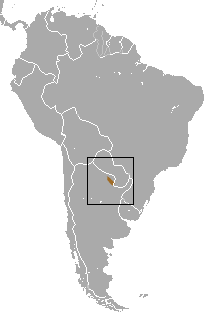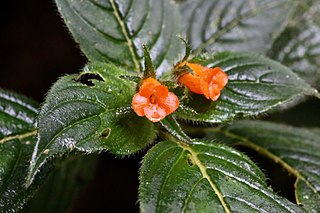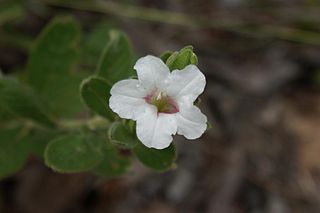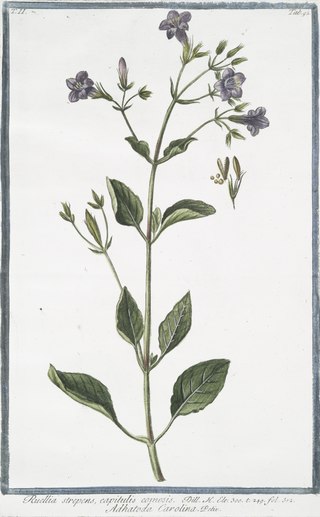
Acanthaceae is a family of dicotyledonous flowering plants containing almost 250 genera and about 2500 species. Most are tropical herbs, shrubs, or twining vines; some are epiphytes. Only a few species are distributed in temperate regions. The four main centres of distribution are Indonesia and Malaysia, Africa, Brazil, and Central America. Representatives of the family can be found in nearly every habitat, including dense or open forests, scrublands, wet fields and valleys, sea coast and marine areas, swamps, and mangrove forests.

The Chacoan pygmy opossum is a recently described genus and species of didelphimorph marsupial. The only species in Chacodelphys, C. formosa, was known until 2004 from only one specimen collected in 1920 in the Chaco of Formosa Province, Argentina. The species is gaining popularity as a pocket pet.

Calliandra is a genus of flowering plants in the pea family, Fabaceae, in the mimosoid clade of the subfamily Caesalpinioideae. It contains about 140 species that are native to tropical and subtropical regions of the Americas.

Besleria is a genus of ca. 200 species of large herbs and soft-stemmed subshrubs or shrubs in the flowering plant family Gesneriaceae. They occur in Central America, South America, and the West Indies.

Ruellia is a genus of flowering plants commonly known as ruellias or wild petunias. They are not closely related to petunias (Petunia) although both genera belong to the same euasterid clade. The genus was named in honor of Jean Ruelle (1474–1537), herbalist and physician to Francis I of France and translator of several works of Dioscorides.

Ruellia brevifolia, the tropical wild petunia or red Christmas pride, is an ornamental plant in the family Acanthaceae. It is native to South America, from Colombia to southern Brazil and northern Argentina.

Ruellia simplex, the Mexican petunia, Mexican bluebell or Britton's wild petunia, is a species of flowering plant in the family Acanthaceae. It is a native of Mexico, the Caribbean, and South America. It has become a widespread invasive plant in Florida, where it was likely introduced as an ornamental before 1933, as well as in the eastern Mediterranean, South Asia and other parts of the eastern hemisphere.

Ruellia humilis is a species of flowering plant in the family Acanthaceae. It is native to the eastern United States. It is grown as an ornamental plant.

Ruellia nitens is a species of flowering plant native to the Cerrado vegetation of central and northeastern Brazil. This plant is cited in Flora Brasiliensis by Carl Friedrich Philipp von Martius.

Ruellia macrantha, or Christmas pride, is a species of flowering plant native to the cerrado vegetation of Brazil. It is often used as an ornamental plant. This plant is cited in Flora Brasiliensis by Carl Friedrich Philipp von Martius.

Ruellia devosiana, the Brazilian wild petunia, is a green ornamental plant of the family Acanthaceae.

Junonia iphita, the chocolate pansy or chocolate soldier, is a butterfly found in Asia.

Ruellia tuberosa, also known as minnieroot, fever root, snapdragon root and sheep potato, is a species of flowering plant in the family Acanthaceae. Its native range is in Central America but it has become naturalized in Africa, South and Southeast Asia.
Ruellia noctiflora, the nightflowering wild petunia, is a herbaceous perennial found along the Gulf coast. Both its specific and common names derive from its habit of nocturnal flowering. In spite of the common name it is in a different family from the garden petunia.

Ruellia affinis, also known as red ruellia or wild petunia, is a vine native to Brazil, which is usually used as an ornamental plant.

Ruellia strepens, commonly known as limestone wild petunia, limestone ruellia, smooth wild petunia, or wild petunia is a species of flowering plant in the family Acanthaceae, native to warmer parts of the central and eastern United States. A perennial herb, it prefers to grow in moist to mesic, partly shady areas such as streamsides and bottomland forests. In the garden it is hardy to USDA zone 5, and can tolerate nearly full shade.















